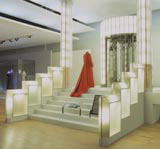Decorative touch
Clare Dowdy visits the Victoria & Albert Museum’s exhibition Art Deco to surround herself in the movement’s geometric designs and bold colours

Glamour and a tight budget may not be convincing bedfellows, but Casson Mann’s economic exhibition design for the Victoria & Albert Museum’s current show, Art Deco 1910-1939, still manages to recreate the feeling of luxury of that era. The exhibition is a sumptuous journey through the influences on and of the movement. It is thoughtfully put together, telling the story of its origins and the effect it had on style around the world.
Three rooms feature more than 300 works, from painting, sculpture, architecture and furniture to textiles, jewellery, graphic art, product design, fashion and film. It was up to Casson Mann to do these pieces justice, and establish the tone and rhythm for the show.
‘Our starting point was light,’ says Roger Mann of Casson Mann. A good place to begin when much of the exhibition display units are cleverly disguised medium-density fibreboard. (The lacquer effect is most convincing.) Lighting tricks played a key role in Art Deco, and both Casson Mann and lighting designer DHA picked up there. In the first room, a long, fin-style wall is back-lit, to give a sense of movement. In the next room, where different countries’ contributions to the style are laid out, the lighting is low level. This allows the star of the show to really shine.
On turning a corner in the second room, visitors come face-to-face with the stunning Strand Palace Hotel’s foyer. The 1930s structure was rescued from destruction by the V&A in 1969, and this is the first time it has been displayed. Light plays another role in the third room, much of which is given over to the impact the movement had on the Manhattan skyline. Here MDF poster hoardings at the back double up as sky scrapers – their long shadows adding to the impression of scale.
Alongside the three-dimensional renditions, photos of New York buildings are projected. These have been taken by Mann (the city’s architecture being a particular fascination of his). It’s not every day that exhibition designers actually get to contribute exhibits to their schemes.
Another money-saving device is seen in the form of a curtain. In the second room, several dresses of the period stand in a glass case. The curtain behind calls to mind catwalks, but it has a practical purpose as well. For such a backdrop provides easy and cost-effective access to the exhibits for gallery staff.
Mann says much of the design budget went on an element that most visitors are unlikely even to notice. In one room, a vast piece of white canvas has been stretched to create an artificial ceiling, and thereby hide the unsightly and un-Art Deco pipes and ducts above.
All this is described in the exhibition text written by curator Ghislaine Wood, with graphics by Graphic Thought Facility. There was some discussion on having the main panels white on black, (something of a departure for the V&A), but it works well and contributes to the impression of the age. And, as Wood says, white on black makes it feel more like a gallery than an exhibition.
Art Deco 1910-1939 runs from 27 March to 20 July, at the V&A, Cromwell Road, London SW7. Visit www.vam.ac.uk or call 020 7942 2000
-
Post a comment



